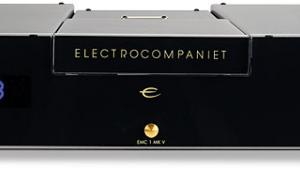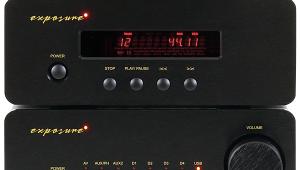Meridian 808.2 Signature Reference (£7195)
Although CD has improved in leaps and bounds since its introduction, the sound initially disappointed many audiophiles and music lovers. One of the first companies to realise that CD replay could be improved was Meridian, giving rise, in 1984, to the Meridian MCD and MCD Pro. Based on a robust Philips mechanism, but with Meridian’s own analogue circuits and oscillator, the MCD Pro really lifted CD sound and a succession of Meridian CD players have continued to set high standards ever since.
The CD-only 808 was launched in 2004, but Meridian has developed its replay technology so far since then that it has significantly re-designed and re-launched it as the 808.2 Signature Reference. The new machine (reviewed exclusively here) incorporates Meridian’s Resolution Enhancement DSP. This uses a new 150MIPS (million instructions per second) processor to up/ oversample the signal to an exact multiple frequency of 176.4kHz with 48-bit internal precision (24-bit output). Meridian claims this ‘perfect’ or ‘true up-sampling’ significantly improves sound quality.
NEW FILTER
Meridian also claims that high-definition sound is achieved from vanilla CD by using a new digital low-pass filter, based on its work on apodizing filters. As with the upsampling, it uses the player’s 150MIPS processor. This filter is claimed to remove supersonic artefacts – called ‘images’ and produced by all DACs – with minimum phase and without adding ripple or pre-echo. Pre-echo is time-smearing not found in nature, or analogue systems. Unlike post-echo, which may be ‘masked’ by the ear, it is potentially much more audible. It’s the bugbear of the sharp digital linear-phase filters used for both anti-aliasing (before the ADC), interpolation (in upsampling) and anti-image filtering (after the DAC). Meridian’s anti-image filter is claimed to combine a very sharp cut-off with, it claims, no pre-ringing [see Lab Report].
Meridian claims this gives the Signature Reference 808.2 ‘perfect’ timing and significantly improved sound quality to provide higher resolution sound from conventional CDs. It is also claimed to correct errors made in the recording itself, by cutting off the signal so hard and sharp above 20kHz that any ringing already present above this filter’s cut-off is removed.
The Signature Reference 808.2 is built with separate high-current power supplies for each circuit section or sub-system. For improved serviceability, reliability and upgradeability, the player is assembled on a mother-daughter circuit board system. The DVD-ROM transport reads the disc in multiple passes, to improve error correction, and there are two FIFO buffers to help reduce jitter. Even the delta-sigma DAC has been improved. Add these elements together in the 808.2 Signature Reference and it makes quite a package.
THE WHEEL DEAL
This is the very latest in a distinguished line of players, although now the price of buying into the top end of the Meridian CD club is £7,195 for the player on review and £8,250 for the ‘i’ version, with its built-in preamplifier. That’s a pretty penny, for mere mortals to contemplate, but should be kept in context with high-spec, high-price high-performance contemporaries such as the Nagra and Linn players. It seems that to buy into the top level in CD players there is now a very expensive membership fee. Though I don’t much like motoring analogies, the 808.2 Signature Reference is no Ford Focus, more of a Bentley in its look and feel: quietly understated, well-built, and solid to the core.
Just lifting it out of the box, loosening the tie-string and removing the player from its protective bag instils an initial reverence. It is physically large and heavy. In less capable hands than Allen Boothroyd’s, the player could have looked very bulky, but the gently contoured cast metal front panel, large display and big keys play down the size, and soften what might otherwise have been a bit of a behemoth.
Outputs around the back include analogue RCA and balanced XLR left/right audio outputs, digital coaxial and the RJ45 sockets and, for computer control, an RS232 connector, a couple of COMS sockets and three trigger sockets. The ‘i’ version (not tested here) has many more inputs for the preamplifier.
Even the remote control is no normal beast, looking more like a mini keyboard, many keys having dual functions via a ‘shift’ key. Though this doubles up as a controller for the preamped ‘i’ version, with many buttons unused, it actually fits neatly into both hands, and so is, if anything, easier to manage than a small one-hand unit. Overall, the player is easy to use – once one gets the hang of the dual-function keys (for example, function plus open for open, which is not really intuitive). The disc is read quickly and ready to play in no time, and the sound – well, that’s something for the following section.
A SPECIAL SOUND
Higher resolution disc storage systems have regrettably not taken hold in the market place, leaving CD as our most widespread high-quality music storage medium. Having piled all its latest technology into the 808.2 Meridian believes it is the best sounding CD player it has ever built and, of course, the proof is in the listening.
I ran the player in for a few hours before serious auditioning, but from the very start it was clear that this CD player is very special. The words lush, smooth, detailed and powerful all cropped up repeatedly through my notes. Superficially, the sound is, if anything, understated and self-effacing. It does not impose ‘clarity’ or ‘detail’, but delivers both in such a measured and precise fashion that the music is brought to life. It seems to eek out subtle musical detail, natural acoustic cues, spatial information and so on. Most notably, treble detail was well presented, with a combination of smoothness and clarity which is rare from CD. The spatial cues helped form a strong and vivid impression of instruments and the musicians playing them. Of course, all this is dependent on a good recording in the first place.
TRY BEETHOVEN
For instance, take the DG ‘4D’ recording of Beethoven’s Violin Sonata Op.30:1, with Gidon Kremer and Martha Agerich on piano. This recording was made using mic preamplifier/AD stages placed close to the microphone, each using 21-bit ADCs and ‘Authentic Bit Imaging’ (DG’s answer to Sony’s ‘Super Bit Mapping’).
This was reproduced with stunning quality. Kremer’s violin was incisive and clear, biting when required, yet avoiding harshness. This was no softened, rolled-off or dulled sound, but also it was not over-emphasised or distorted. In this recording the treble seems much extended and the violin might sound sharp and wiry with less than ideal players, but there was little trace of such unnaturalness. Kremer’s short intakes of breath were also perfectly audible as he was playing. The acoustics around the violin were quite apparent, giving it a genuine sense of position.
Likewise, Argerich’s piano had real presence, but in a way I had not expected. As each key was pressed the power and impact of hammer on string was palpable. It was as though the air pulsed in synchronism. The piano had warmth, power and clarity but, again, without excess edge or brittleness. Maybe this is due to the ‘time-perfect’ filter not blurring the transient rise and timing of harmonic waveforms, so that they all happen at the right instant, or maybe it is due to other factors. I don’t know, but the effect is there right enough, making most other players sound anaemic.
Of course one cannot expect the CD player to improve rubbishy recordings, but if the quality is there in the first place, the Signature Reference 808.2 will bring it out.
RAW POWER
Take another Beethoven example, one with less than perfect sound quality: the EMI symphony cycle made with Sir Simon Rattle and the Vienna Philharmonic. These are generally quite dense recordings. They can sound constricted in the bass and midrange, and coarse or even harsh in the treble, especially with less sympathetic players. The Meridian does a very competent job with these discs. Take the Fifth Symphony for example: the sound was still densely presented, but the sheer power of this work came through. Here we have a relentless rhythmical pounding from the orchestra, yet all instruments stayed separate, despite that. The strings sounded maybe the best I have heard with this CD via any other player. The sound was still not perfect by any means, but it so conveyed the feeling of the music that I was satisfied enough to listen right through and enjoy it.
MOVE ON TO JAZZ
With the Miles Davis ‘Kind of Blue’ (on Columbia Legacy ‘Super Bit Mapped’), I heard possibly the freshest and most immediate replay of this CD. Taking ‘So what’ as an example, the clarinet was rich and reedy and the music really ‘swung’. Cymbals rode and rang clearly and the timing of sticks on metal and skin were obvious. Rim shots had power and precision; Miles’ trumpet had warmth and richness, being so focused in clarity that the gentle addition and variation of echo-plate was quite clear. Miles’ exquisite phrasing was there to be heard – again it was about the music, and critical analysis leaves mere words inadequate to describe what was musically obvious.
Many other discs were of course played. The result was generally the same – a convincing replay of music, with warmth and a solid, palpable presence. The sound does not equate with 24/96 or SACD done well, but the resolution does seem greater than usual with CD.
This player limits the edginess typical of CD and so has less artificial treble grain and ‘sparkle’. It does not shout ‘clarity’ but the sound of the real instruments, their harmonics, separation, timing, power and acoustic space – in short, naturalness – is perfectly clear.
VERDICT
Meridian’s Bentley of a player replays stereo CDs with surprising clarity and precision. Packed with the latest technology, it is not a cheap player, but the warmth, transparency, dynamic impact and musical presence are hard to beat from the CD medium. As much for the heart as the head, the Signature Reference 808.2 will reward the listener with music many times over.
Originally published in the June 2008 issue

























































